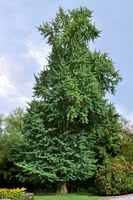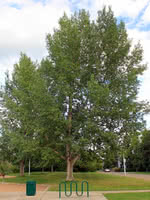Mon-Fri 9am - 5pm Mountain time
Ginkgo Biloba vs Assiniboine Poplar
Ginkgo biloba
Populus x Assiniboine
NOT AVAILABLE THIS SEASON - MIGHT RETURN
The Ginkgo Biloba is regarded as one of the most distinctive and beautiful of all the deciduous trees, and has remained genetically unchanged for millions of years. Its beautifully fan-shaped leaves develop a clear yellow colour in fall. Graceful and attractive year-round, Ginkgo is the perfect conversation starter in your yard.
Assiniboine poplar is a tall, fast growing tree that has a shapely oval form and dense foliage. This hybrid poplar is a male clone and produces no fuzz or fluff. Assiniboine poplar can handle tough conditions such as: urban pollution, environmental salt, drought, poor soil, and even some standing water.
Ginkgo Biloba Quick Facts
Assiniboine Poplar Quick Facts
Toxicity: Uncooked nuts in large quantities
In row spacing: 2.4 - 3 m (8 - 10 ft)

